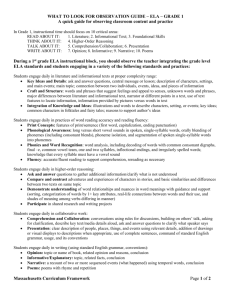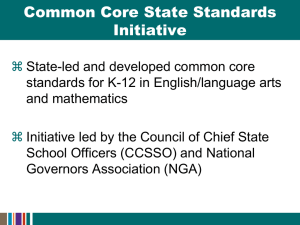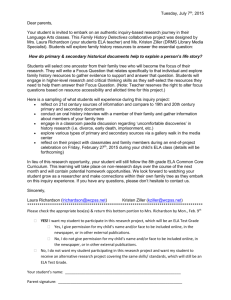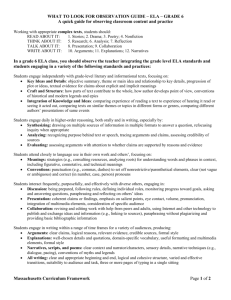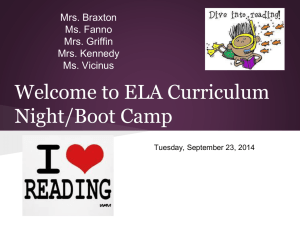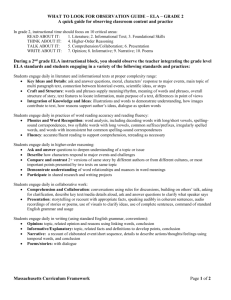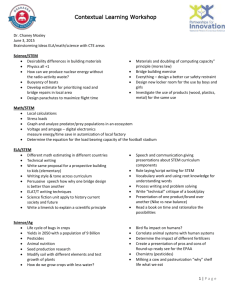Instr Seq
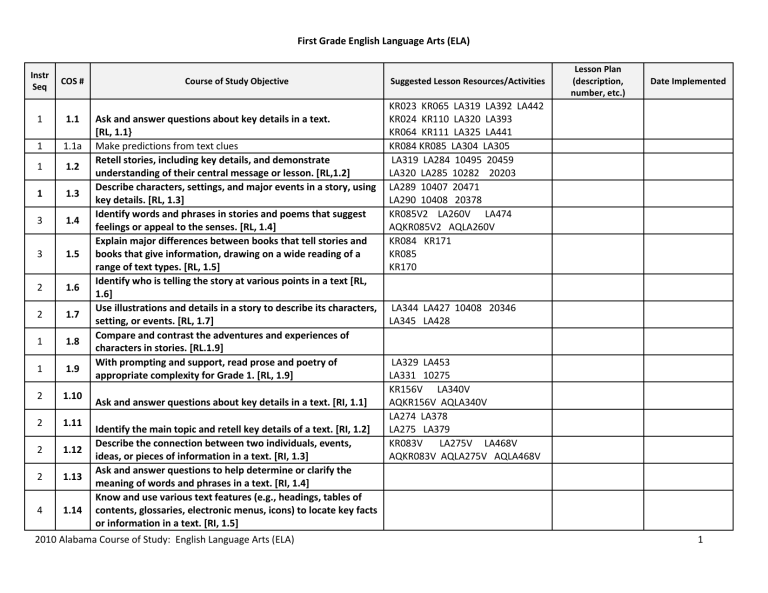
First Grade English Language Arts (ELA)
Instr
Seq
COS # Course of Study Objective Suggested Lesson Resources/Activities
1 1.1 Ask and answer questions about key details in a text.
[RL, 1.1}
1 1.1a Make predictions from text clues
1
1
3
3
2
1.2
1.3
1.4
1.5
1.6
Retell stories, including key details, and demonstrate understanding of their central message or lesson. [RL,1.2]
Describe characters, settings, and major events in a story, using key details. [RL, 1.3]
Identify words and phrases in stories and poems that suggest feelings or appeal to the senses. [RL, 1.4]
Explain major differences between books that tell stories and books that give information, drawing on a wide reading of a range of text types. [RL, 1.5]
Identify who is telling the story at various points in a text [RL,
1.6]
2
1
1
1.7
1.8
1.9
Use illustrations and details in a story to describe its characters, setting, or events. [RL, 1.7]
Compare and contrast the adventures and experiences of characters in stories. [RL.1.9]
With prompting and support, read prose and poetry of appropriate complexity for Grade 1. [RL, 1.9]
2 1.10
2
2
2
4
1.11
1.12
1.13
1.14
Ask and answer questions about key details in a text. [RI, 1.1]
Identify the main topic and retell key details of a text. [RI, 1.2]
Describe the connection between two individuals, events, ideas, or pieces of information in a text. [RI, 1.3]
Ask and answer questions to help determine or clarify the meaning of words and phrases in a text. [RI, 1.4]
Know and use various text features (e.g., headings, tables of contents, glossaries, electronic menus, icons) to locate key facts or information in a text. [RI, 1.5]
2010 Alabama Course of Study: English Language Arts (ELA)
KR023 KR065 LA319 LA392 LA442
KR024 KR110 LA320 LA393
KR064 KR111 LA325 LA441
KR084 KR085 LA304 LA305
LA319 LA284 10495 20459
LA320 LA285 10282 20203
LA289 10407 20471
LA290 10408 20378
KR085V2 LA260V LA474
AQKR085V2 AQLA260V
KR084 KR171
KR085
KR170
LA344 LA427 10408 20346
LA345 LA428
LA329 LA453
LA331 10275
KR156V LA340V
AQKR156V AQLA340V
LA274 LA378
LA275 LA379
KR083V LA275V LA468V
AQKR083V AQLA275V AQLA468V
Lesson Plan
(description,
number, etc.)
Date Implemented
1
1
3
3
1.21d
1.22
1.22a
First Grade English Language Arts (ELA)
Instr
Seq
COS # Course of Study Objective
2
1
2
2
3
2
2 1.20a
1
1.15
1.16
1.17
1.18
1.19
1.20
1.21
1 1.21a
1 1.21b
Distinguish between information provided by pictures or other illustrations and information provided by the words in a text.
[RI, 1.6]
Use the illustrations and details in a text to describe its key ideas. [RL, 1.7]
Identify the reasons an author gives to support points in a text.
[RI, 1.8]
Identify basic similarities in and differences between two texts on the same topic (e.g., in illustrations, descriptions, or procedures). [RI.1.9]
With prompting and support, read informational texts appropriately complex for Grade 1. [RL, 1.10]
Demonstrate understanding of the organization and basic features of print. [RF, 1.1]
Recognize the distinguishing features of a sentence (e.g., first word, capitalization, ending punctuation). [RF, 1.1a]
Demonstrate understanding of spoken words, syllables, and sounds (phonemes). [RF, 1.2]
Distinguish long from short vowel sounds in spoken singlesyllable words. [RF, 1.2a]
Orally produce single-syllable words by blending sounds
(phonemes), including consonant blends. [RF, 1.2b]
1 1.21c Isolate and pronounce initial, medial vowel, and final sounds
(phonemes) in spoken single-syllable words. [RF, 1.2c]
Segment spoken single-syllable words into their complete sequence of individual sounds (phonemes). [RF, 1.2d]
Know and apply grade-level phonics and word analysis skills in decoding words. [RF, 1.3]
Know the spelling-sound correspondences for common consonant digraphs. [RF, 1.3a]
3 1.22b Decode regularly spelled one-syllable words. [RF, 1.3b]
Suggested Lesson Resources/Activities
LA477V
AQLA477V
KR084 LA324
LA274
KR010
KR041 KR113 LA060 LA142
KR042 KR114 LA096
KR058 KR151
KR100 LA101
KR071 KR135 LA147
KR104 LA026
KR147 KR055 KR088
KR202 KR151
KR029 LA076
KR127 LA101 KR136
KR137 KR138
LA022 LA037 LA402
LA032 LA56
KR044 KR106 KR132
Lesson Plan
(description,
number, etc.)
2010 Alabama Course of Study: English Language Arts (ELA)
Date Implemented
2
First Grade English Language Arts (ELA)
Instr
Seq
COS # Course of Study Objective
3 1.22c
3 1.22d
3 1.22e
Know final –e and common vowel team conventions for representing long vowel sounds. [RF, 1.3c]
Use knowledge that every syllable must have a vowel sound to determine the number of syllables in a printed word. [RF, 1.3d]
Decode two-syllable words following basic patterns by breaking the words into syllables. [RF, 1.3e]
3
3 1.22g
2
1.22f
1.23
Read words with inflectional endings. [RF, 1.3f]
Recognize and read grade-appropriate irregularly spelled words.
[RF, 1.3g]
Read with sufficient accuracy and fluency to support comprehension. [RF, 1.4]
Suggested Lesson Resources/Activities
LA061 LA102 LA353
LA097 LA143 10394
KR019 KR020 KR021
20355
LA237 KR021
LA263P AQLA263P
LA275V2 AQLA275V2 LA315V
AQLA315V
LA003 LA011 LA023 LA098
LA007 LA019 LA033 LA170
LA271 LA495 LA260 LA305
LA311 LA259 LA304 LA372
LA434 LA476 LA511 LA525
LA435 LA477 LA512 LA526
LA261 LA316 LA331 LA460
LA301 LA326 LA341 LA467
LA449V LA300V2 AQLA300V2
AQLA449V
2 1.23a
2 1.23b
2
4
4
4
4
1.23c
1.24
1.25
1.26
1.27
Read on-level text with purpose and understanding. [RF, 1.4a]
Read on-level text orally with accuracy, appropriate rate, and expression on successive readings. [RF, 1.4b]
Use context to confirm or self-correct word recognition and understanding, rereading as necessary. [RF, 1.4c]
Write opinion pieces in which they introduce the topic or name the book they are writing about, state an opinion, supply a reason for the opinion, and provide some sense of closure. [W,
1.1]
Write informative or explanatory texts in which they name a topic, supply some facts about the topic, and provide some sense of closure. [W, 1.2]
Write narratives in which they recount two or more appropriately sequenced events, include some details, regarding what happened, use temporal words to signal event order, and provide some sense of closure. [W, 1.3]
With guidance and support from adults, focus on a topic, respond to questions and suggestions from peers, and add details to strengthen writing as needed. [W, 1.5]
Lesson Plan
(description,
number, etc.)
Date Implemented
2010 Alabama Course of Study: English Language Arts (ELA) 3
First Grade English Language Arts (ELA)
Instr
Seq
COS # Course of Study Objective
4
4
4
1
1
2
1
2
1.28
1.29
1.30
1.31
1.32
1.32
1.33
1.33
With guidance and support from adults, use a variety of digital tools to produce and publish writing, including in collaboration with peers. [W, 1.6]
Participate in shared research and writing projects (e.g., explore a number of “how-to” books on a given topic and use them to write a sequence of instructions). [W, 1.7]
With guidance and support from adults, recall information from experiences or gather information from provided sources to answer a question. [W, 1.8]
Participate in collaborative conversations with diverse partners about Grade 1 topics and texts with peers and adults in small and larger groups. [SL, 1.1]
Ask and answer questions about key details in a text read aloud or information presented orally or through other media. [SL,
1.2]
Ask and answer questions about key details in a text read aloud or information presented orally or through other media. [SL,
1.2]
Ask and answer questions about what a speaker says in order to gather additional information or clarify something that is not understood.
Ask and answer questions about what a speaker says in order to gather additional information or clarify something that is not understood. [SL. 1.3]
2
2
2
1.34
1.35
1.36
Describe people, places, things, and events with relevant details, expressing ideas and feelings clearly. [SL, 1.4]
Add drawings or other visuals displays to descriptions when appropriate to clarify ideas, thoughts and feelings. [SL, 1.5]
Produce complete sentences when appropriate to task and situation. [SL 1.6]
3 1.37
Demonstrate command of the conventions of Standard English grammar and usage when writing or speaking. [L, 1.1]
3 1.37a Print all upper and lower case letters. [L, 1.1a]
2010 Alabama Course of Study: English Language Arts (ELA)
Suggested Lesson Resources/Activities
Lesson Plan
(description,
number, etc.)
Date Implemented
4
First Grade English Language Arts (ELA)
Instr
Seq
COS # Course of Study Objective Suggested Lesson Resources/Activities
3 1.37b Use common, proper and possessive nouns. [L, 1.1b]
3
3
1.37c
1.37d
Use singular and plural nouns with matching verbs in basic sentences (e.g., He hops; We hop). [L, 1.1c]
Use personal, possessives, and indefinite pronouns (e.g., I,
me,my; they, them, their; anyone, everything). [L, 1.1d]
Use verbs to convey a sense of past, present, and future (e.g.
Yesterday I walked home; Today I walk home; Tomorrow I will 3 1.37e
walk home.). [L, 1.1g]
3 1.37f Use frequently occurring adjectives. [L, 1.1f]
3
3
1.37g
1.37j
Use frequently occurring conjunctions 9E.g., and but, or, so , because).[L, 1.1i]
3 1.37h Use determiners (e.g., articles, demonstratives). [L, 1.1h]
3 1.37i Use frequently occurring prepositions
Produce and expand complete simple and compound declarative, interrogative, imperative, and exclamatory sentences in response to prompts. [L, 1.1j]
KR112
KR066
KR037 KR099 KR159
2 1.38 Demonstrate command of the conventions of Standard English capitalization, punctuation, and spelling when writing. [L, 1.2]
2 1.38a Capitalize dates and names of people. [L, 1.2a]
2 1.38b Use end punctuation for sentences. [L, 1.2b]
2 1.38c
Use commas in dates and to separate single words in a series. [L,
1.2c]
2
2
4
4
1.38d
1.38e
1.39
1.39a
Use conventional spelling for words with common spelling patterns and for frequently occurring irregular words. [L. 1.2d]
Spell untaught words phonetically, drawing on phonemic awareness and spelling conventions. [L, 1.2e]
Determine or clarify the meaning of unknown and multiplemeaning words and phrases based on Grade 1 reading and
content, choosing flexibility from an array of strategies. [L, 1.4]
Use sentence-level context as a clue to the meaning of a word or phrase. [L, 1.4a]
LA002
LA014
LA027
KR043 KR040
Lesson Plan
(description,
number, etc.)
2010 Alabama Course of Study: English Language Arts (ELA)
Date Implemented
5
First Grade English Language Arts (ELA)
Instr
Seq
COS # Course of Study Objective Suggested Lesson Resources/Activities
Lesson Plan
(description,
number, etc.)
Date Implemented
4
4
1.39b
1.39c
Use frequently occurring affixes as a clue to the meaning of a word. [L, 1.4b]
Identify frequently occurring root words (e.g., look) and their inflectional forms (e.g., looks, looked, looking). [L, 1.4c]
4 1.39d
Apply alphabetical order to the first letter of words to access information
With guidance and support from adults, demonstrate
2 1.40 understanding of word relationships and nuances in word meanings. [L, 1.5]
2 1.40a Sort words into categories (e.g. colors, clothing)
2
2
1.40b
1.40c
Define words by category and by one or more key attributes (e.g. a duck is a bird that swims; a tiger is a large cat with stripes). [L,
1.5b]
Identify real-life connections between words and their use (e.g., note places at home that are cozy). [L, 1.5c]
2
1
1.40d
1.41
Distinguish shades of meaning among verbs differing in manner
(e.g., look, peek, glance, stare) and adjectives differing in intensity (e.g. large, gigantic) by defining or choosing them or by acting out the meanings. [L, 1.5d]
Use words and phrases acquired through conversations, reading and being read to, and responding to texts, including frequently occurring conjunctions to signal simple relationships
(e.g., because).
Reading Foundations (RF) includes the wide range of processes from early recognition that letters and combinations of letters represent sounds to the more complex knowledge of roots and affixes, use of context clues, and fluent reading with accuracy and expression.
Reading Literature (RL) standards range from the ability in the early grades to retell stories with key details and describe characters and settings to the ability in senior high grades to support analysis of how a theme develops over the course of a text.
Reading Informational Text (RI) standards are identical to literature standards but must be applied to informational text in each grade.
Writing (W) standards are demanding even in the early grades and present clear and specific expectations for opinion pieces, informative or explanatory text, and narrative text. Shared research projects and use of digital tools are important elements in this strand throughout the grades.
2010 Alabama Course of Study: English Language Arts (ELA) 6
First Grade English Language Arts (ELA)
Speaking and Listening (SL) standards require students to collaborate for both comprehension and presentation. Preparation for discussions is emphasized across the grades, as is following agreed-upon rules. Students learn to adapt speech to a variety of contexts and tasks, which they apply in all subject areas and life endeavors.
Language (L) standards require early understanding and application of the conventions of Standard English, with specific increasing expectations listed at each grade level. Knowledge of language and its conventions is applied to writing, speaking, reading, and listening. Vocabulary development also receives continuing emphasis in the language strand.
2010 Alabama Course of Study: English Language Arts (ELA) 7
